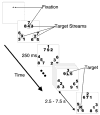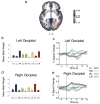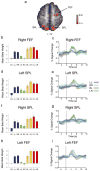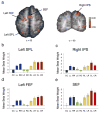Cortical mechanisms for shifting and holding visuospatial attention
- PMID: 17434917
- PMCID: PMC2150997
- DOI: 10.1093/cercor/bhm036
Cortical mechanisms for shifting and holding visuospatial attention
Abstract
Access to visual awareness is often determined by covert, voluntary deployments of visual attention. Voluntary orienting without eye movements requires decoupling attention from the locus of fixation, a shift to the desired location, and maintenance of attention at that location. We used event-related functional magnetic resonance imaging to dissociate these components while observers shifted attention among 3 streams of letters and digits, one located at fixation and 2 in the periphery. Compared with holding attention at the current location, shifting attention between the peripheral locations was associated with transient increases in neural activity in the superior parietal lobule (SPL) and frontal eye fields (FEF), as in previous studies. The supplementary eye fields and separate portions of SPL and FEF were more active for decoupling attention from fixation than for shifting attention to a new location. Large segments of precentral sulcus (PreCS) and posterior parietal cortex (PPC) were more active when attention was maintained in the periphery than when it was maintained at fixation. We conclude that distinct subcomponents of the dorsal frontoparietal network initiate redeployments of covert attention to new locations and disengage attention from fixation, while sustained activity in lateral regions of PPC and PreCS represents sustained states of peripheral attention.
Figures








References
-
- Andersen RA, Buneo CA. Intentional maps in posterior parietal cortex. Annu Rev Neurosci. 2002;25:189–220. - PubMed
-
- Awh E, Matsukura M, Serences JT. Top-down control of biased competition during covert spatial orienting. J Exp Psychol Hum Percept Perform. 2003;29:52–63. - PubMed
-
- Awh E, Armstrong KM, Moore T. Visual and oculomotor selection: links, causes and implications for spatial attention. Trends Cog Sci. 2006;10:124–130. - PubMed

